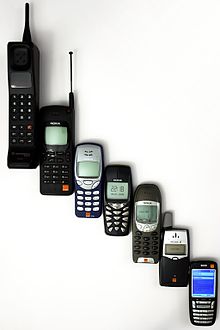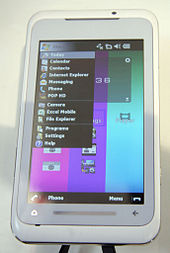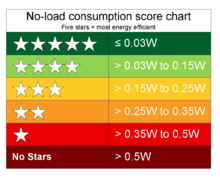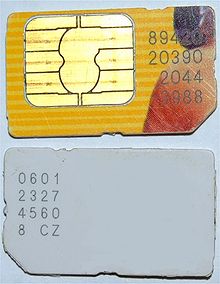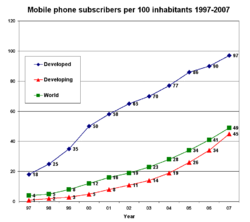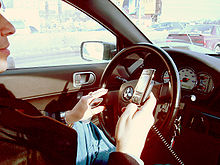- Mobile phone
-
"Cell Phone" redirects here. For the film, see Cell Phone (film)."Handphone" redirects here. For the film, see Handphone (film).
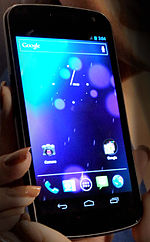 The Galaxy Nexus, an example of a smartphone
The Galaxy Nexus, an example of a smartphone
A mobile phone (also known as a cellular phone, cell phone and a hand phone) is a device which can make and receive telephone calls over a radio link whilst moving around a wide geographic area. It does so by connecting to a cellular network provided by a mobile network operator. The calls are to and from the public telephone network which includes other mobiles and fixed-line phones across the world. By contrast, a cordless telephone is used only within the short range of a single, private base station.
In addition to telephony, modern mobile phones also support a wide variety of other services such as text messaging, MMS, email, Internet access, short-range wireless communications (infrared, Bluetooth), business applications, gaming and photography. Mobile phones that offer these and more general computing capabilities are referred to as smartphones.
The first hand-held mobile phone was demonstrated by Dr Martin Cooper of Motorola in 1973, using a handset weighing 2 1/2 lbs (about 1 kg).[1] In 1983, the DynaTAC 8000x was the first to be commercially available. In the twenty years from 1990 to 2010, worldwide mobile phone subscriptions grew from 12.4 million to over 4.6 billion, penetrating the developing economies and reaching the bottom of the economic pyramid.[2][3][4]
Contents
History
Main article: History of mobile phonesRadiophones have a long and varied history going back to Reginald Fessenden's invention and shore-to-ship demonstration of radio telephony, through the Second World War with military use of radio telephony links and civil services in the 1950s.
The first mobile telephone call made from a car occurred in St. Louis, Missouri, USA on June 17, 1946, using the Bell System's Mobile Telephone Service. The equipment weighed 80 pounds (36 kg), and the AT&T service, basically a massive party line, cost US$30 per month (equal to $337.33 today) plus 30–40 cents per local call, equal to $3.37 to $4.50 today.[5]
In 1956, the world’s first partly automatic car phone system, Mobile System A (MTA), was launched in Sweden. MTA phones were composed of vacuum tubes and relays, and had a weight of 40 kg. In 1962, a more modern version called Mobile System B (MTB) was launched, which was a push-button telephone, and which used transistors to enhance the telephone’s calling capacity and improve its operational reliability, thereby reducing the weight of the apparatus to 10 kg. In 1971, the MTD version was launched, opening for several different brands of equipment and gaining commercial success.[6][7]
Martin Cooper, a Motorola researcher and executive is considered to be the inventor of the first practical mobile phone for handheld use in a non-vehicle setting, after a long race against Bell Labs for the first portable mobile phone. Using a modern, if somewhat heavy portable handset, Cooper made the first call on a handheld mobile phone on April 3, 1973 to his rival, Dr. Joel S. Engel of Bell Labs.[8]
The first commercially automated cellular network (the 1G) was launched in Japan by NTT in 1979, initially in the metropolitan area of Tokyo. Within five years, the NTT network had been expanded to cover the whole population of Japan and became the first nationwide 1G network. In 1981, this was followed by the simultaneous launch of the Nordic Mobile Telephone (NMT) system in Denmark, Finland, Norway and Sweden.[9] NMT was the first mobile phone network featuring international roaming. The first 1G network launched in the USA was Chicago-based Ameritech in 1983 using the Motorola DynaTAC mobile phone. Several countries then followed in the early-to-mid 1980s including the UK, Mexico and Canada.
The first "modern" network technology on digital 2G (second generation) cellular technology was launched by Radiolinja (now part of Elisa Group) in 1991 in Finland on the GSM standard, which also marked the introduction of competition in mobile telecoms when Radiolinja challenged incumbent Telecom Finland (now part of TeliaSonera) who ran a 1G NMT network.
In 2001, the launch of 3G (Third Generation) was again in Japan by NTT DoCoMo on the WCDMA standard.[10]
One of the newest 3G technologies to be implemented is High-Speed Downlink Packet Access (HSDPA). It is an enhanced 3G (third generation) mobile telephony communications protocol in the high-speed packet access (HSPA) family, also coined 3.5G, 3G+ or turbo 3G, which allows networks based on Universal Mobile Telecommunications System (UMTS) to have higher data transfer speeds and capacity.
Features
Main articles: Mobile phone features and SmartphoneAll mobile phones have a number of features in common, but manufacturers also try to differentiate their own products by implementing additional functions to make them more attractive to consumers. This has led to great innovation in mobile phone development over the past 20 years.
The common components found on all phones are:
- A battery, providing the power source for the phone functions.
- An input mechanism to allow the user to interact with the phone. The most common input mechanism is a keypad, but touch screens are also found in some high-end smartphones.
- Basic mobile phone services to allow users to make calls and send text messages.
- All GSM phones use a SIM card to allow an account to be swapped among devices. Some CDMA devices also have a similar card called a R-UIM.
- Individual GSM, WCDMA, iDEN and some satellite phone devices are uniquely identified by an International Mobile Equipment Identity (IMEI) number.
Low-end mobile phones are often referred to as feature phones, and offer basic telephony, as well as functions such as playing music and taking photos, and sometimes simple applications based on generic managed platforms such as Java ME or BREW. Handsets with more advanced computing ability through the use of native software applications became known as smartphones. The first smartphone was the Nokia 9000 Communicator in 1996 which added PDA functionality to the basic mobile phone at the time. As miniaturization and increased processing power of microchips has enabled ever more features to be added to phones, the concept of the smartphone has evolved, and what was a high-end smartphone five years ago, is a standard phone today.
Several phone series have been introduced to address a given market segment, such as the RIM BlackBerry focusing on enterprise/corporate customer email needs; the SonyEricsson Walkman series of musicphones and Cybershot series of cameraphones; the Nokia Nseries of multimedia phones, the Palm Pre the HTC Dream and the Apple iPhone.
Other features that may be found on mobile phones include GPS navigation, music (MP3) and video (MP4) playback, RDS radio receiver, alarms, memo recording, personal digital assistant functions, ability to watch streaming video, video download, video calling, built-in cameras (1.0+ Mpx) and camcorders (video recording), with autofocus and flash, ringtones, games, PTT, memory card reader (SD), USB (2.0), dual line support, infrared, Bluetooth (2.0) and WiFi connectivity, instant messaging, Internet e-mail and browsing and serving as a wireless modem. Nokia and the University of Cambridge demonstrated a bendable cell phone called the Morph.[11] Some phones can make mobile payments via direct mobile billing schemes or through contactless payments if the phone and point of sale support Near Field Communication (NFC).[12] Some of the largest mobile phone manufacturers and network providers along with many retail merchants support, or plan to support, contactless payments through NFC-equipped mobile phones.[13][14][15]
Some phones have an electromechanical transducer on the back which changes the electrical voice signal into mechanical vibrations. The vibrations flow through the cheek bones or forehead allowing the user to hear the conversation. This is useful in the noisy situations or if the user is hard of hearing. [16]
Software and applications
See also: Mobile Industry Processor InterfaceThe most commonly used data application on mobile phones is SMS text messaging. The first SMS text message was sent from a computer to a mobile phone in 1992 in the UK, while the first person-to-person SMS from phone to phone was sent in Finland in 1993.
Other non-SMS data services used on mobile phones include mobile music, downloadable logos and pictures, gaming, gambling, adult entertainment and advertising. The first downloadable mobile content was sold to a mobile phone in Finland in 1998, when Radiolinja (now Elisa) introduced the downloadable ringtone service. In 1999, Japanese mobile operator NTT DoCoMo introduced its mobile Internet service, i-Mode, which today is the world's largest mobile Internet service.
The first mobile news service, delivered via SMS, was launched in Finland in 2000. Mobile news services are expanding with many organizations providing "on-demand" news services by SMS. Some also provide "instant" news pushed out by SMS.
Mobile payments were first trialled in Finland in 1998 when two Coca-Cola vending machines in Espoo were enabled to work with SMS payments. Eventually, the idea spread and in 1999 the Philippines launched the first commercial mobile payments systems, on the mobile operators Globe and Smart. Today, mobile payments ranging from mobile banking to mobile credit cards to mobile commerce are very widely used in Asia and Africa, and in selected European markets.
Power supply
Mobile phones generally obtain power from rechargeable batteries. There are a variety of ways used to charge cell phones, including USB, portable batteries, mains power (using an AC adapter), cigarette lighters (using an adapter), or a dynamo. In 2009, the first wireless charger was released for consumer use.[17]
Various initiatives, such as the EU Common External Power Supply have been announced to standardize the interface to the charger, and to promote energy efficiency of mains-operated chargers. A star rating system is promoted by some manufacturers, where the most efficient chargers consume less than 0.03 watts and obtain a five-star rating.
Battery
A popular early mobile phone battery was the nickel metal-hydride (NiMH) type, due to its relatively small size and low weight. Lithium ion batteries are also used, as they are lighter and do not have the Voltage depression due to long-term over-charging that nickel metal-hydride batteries do. Many mobile phone manufacturers use lithium–polymer batteries as opposed to the older Lithium-Ion, the main advantages being even lower weight and the possibility to make the battery a shape other than strict cuboid.[19] Mobile phone manufacturers have been experimenting with alternative power sources, including solar cells.[20]
SIM card
Main articles: Subscriber Identity Module and Removable User Identity ModuleGSM mobile phones require a small microchip called a Subscriber Identity Module or SIM Card, to function. The SIM card is approximately the size of a small postage stamp and is usually placed underneath the battery in the rear of the unit. The SIM securely stores the service-subscriber key (IMSI) used to identify a subscriber on mobile telephony devices (such as mobile phones and computers). The SIM card allows users to change phones by simply removing the SIM card from one mobile phone and inserting it into another mobile phone or broadband telephony device.
A SIM card contains its unique serial number, internationally unique number of the mobile user (IMSI), security authentication and ciphering information, temporary information related to the local network, a list of the services the user has access to and two passwords (PIN for usual use and PUK for unlocking).
SIM cards are available in three standard sizes. The first is the size of a credit card (85.60 mm × 53.98 mm x 0.76 mm, defined by ISO/IEC 7810 as ID-1). The newer, most popular miniature version has the same thickness but a length of 25 mm and a width of 15 mm (ISO/IEC 7810 ID-000), and has one of its corners truncated (chamfered) to prevent misinsertion. The newest incarnation known as the 3FF or micro-SIM has dimensions of 15 mm × 12 mm. Most cards of the two smaller sizes are supplied as a full-sized card with the smaller card held in place by a few plastic links; it can easily be broken off to be used in a device that uses the smaller SIM.
The first SIM card was made in 1991 by Munich smart card maker Giesecke & Devrient for the Finnish wireless network operator Radiolinja. Giesecke & Devrient sold the first 300 SIM cards to Elisa (ex. Radiolinja).
Those cell phones that do not use a SIM Card have the data programmed in to their memory. This data is accessed by using a special digit sequence to access the "NAM" as in "Name" or number programming menu. From there, information can be added, including a new number for the phone, new Service Provider numbers, new emergency numbers, new Authentication Key or A-Key code, and a Preferred Roaming List or PRL. However, to prevent the phone being accidentally disabled or removed from the network, the Service Provider typically locks this data with a Master Subsidiary Lock (MSL). The MSL also locks the device to a particular carrier when it is sold as a loss leader.
The MSL applies only to the SIM, so once the contract has expired, the MSL still applies to the SIM. The phone, however, is also initially locked by the manufacturer into the Service Provider's MSL. This lock may be disabled so that the phone can use other Service Providers' SIM cards. Most phones purchased outside the U.S. are unlocked phones because there are numerous Service Providers that are close to one another or have overlapping coverage. The cost to unlock a phone varies but is usually very cheap and is sometimes provided by independent phone vendors.
A similar module called a Removable User Identity Module or RUIM card is present in some CDMA networks, notably in China and Indonesia.
Multi-card hybrid phones
A hybrid mobile phone can take more than one SIM card, even of different types. The SIM and RUIM cards can be mixed together, and some phones also support three or four SIMs.[21][22]
From 2010 onwards they became popular in India and Indonesia and other emerging markets,[23] attributed to the desire to obtain the lowest on-net calling rate. In Q3 2011, Nokia shipped 18 million of its low cost dual SIM phone range in an attempt to make up lost ground in the higher end smartphone market.[24]
Display
Mobile phones have a display device, some of which are also touch screens. The screen size varies greatly by model and is usually specified either as width and height in pixels or the diagonal measured in inches.
Some mobiles have more than one display, for example the Kyocera Echo, an Android smartphone with a dual 3.5 inch screen. The screens can also be combined into a single 4.7 inch tablet style computer.[25]
Central processing unit
Mobile phones have central processing units (CPUs), similar to those in computers, but optimised to operate in low power environments.
Mobile CPU performance depends not only on the clock rate (generally given in multiples of hertz)[26] but also the memory hierarchy also greatly affects overall performance. Because of these problems, the performance of mobile phone CPUs is often more appropriately given by scores derived from various standardized tests to measure the real effective performance in commonly used applications.
Manufacturers
See also: List of best-selling mobile phones
The world's largest individual mobile operator by subscribers is China Mobile with over 500 million mobile phone subscribers.[27] Over 50 mobile operators have over 10 million subscribers each, and over 150 mobile operators have at least one million subscribers by the end of 2009 (source wireless intelligence). In February 2010, there were 4.6 billion mobile phone subscribers, a number that is estimated to grow.[4]
Prior to 2010, Nokia was the market leader. However, during that year competition emerged in the Asia Pacific region with brands such as Micromax, Nexian, and i-Mobile and chipped away at Nokia's market share. Android powered smartphones also gained momentum across the region at the expense of Nokia. In India, their market share also dropped significantly to around 31 percent from 56 percent in the same period. Their share was displaced by Chinese and Indian vendors of low-end mobile phones.[28]
In 2010 worldwide sales were 1.6 billion units, an increase of 31.8 percent from 2009. The top five manufacturers by market share were Nokia followed by Samsung, LG Electronics, ZTE and Apple. The last three replaced RIM, Sony Ericsson and Motorola who were previously among the top five list.[29][30] Outside the top five a significant market share increase from 16.5 percent to 30.6 percent was achieved by many smaller and new brands.
In Q1 2011, Apple surpassed Nokia as the world's biggest handset vendor by revenue, as Nokia's market share dropped to 29 percent in Q1 2011, the lowest level since the late 1990s. In June 2011, Nokia announced lower expectations for sales and margin due to global competition in both low-and-high end markets.[31]
By Q2 2011, worldwide sales grew 16.5 percent to 428.7 million units.
Top five manufacturers by market share in Q2 2011 Manufacturer Gartner [32] IDC [33] Nokia 22.8% 24.2% SAMSUNG 16.3% 19.2% LG 5.7% 6.8% Apple 4.6% 5.6% ZTE 3.0% 4.5% Others 47.6% 39.7% - Note: Vendor shipments are branded shipments and exclude OEM sales for all vendors
Other manufacturers outside the top five are Research In Motion Ltd. (RIM), HTC Corporation, Motorola, Huawei, Sony Ericsson. Smaller players include Audiovox (now UTStarcom), BenQ-Siemens, CECT, Fujitsu, Kyocera, Mitsubishi Electric, NEC, Panasonic, Palm, Pantech Wireless Inc., Philips, Qualcomm Inc., Sagem, Sanyo, Sharp, Sierra Wireless, Just5, SK Teletech, T&A Alcatel, Trium, Toshiba, and Vidalco.
Use of mobile phones
In general
Mobile phones are used for a variety of purposes, including keeping in touch with family members, conducting business, and having access to a telephone in the event of an emergency. Some people carry more than one cell phone for different purposes, such as for business and personal use. Multiple SIM cards may also be used to take advantage of the benefits of different calling plans—a particular plan might provide cheaper local calls, long-distance calls, international calls, or roaming. A study by Motorola found that one in ten cell phone subscribers have a second phone that often is kept secret from other family members. These phones may be used to engage in activities including extramarital affairs or clandestine business dealings.[34] The mobile phone has also been used in a variety of diverse contexts in society, for example:
- Organizations that aid victims of domestic violence may offer a cell phone to potential victims without the abuser's knowledge. These devices are often old phones that are donated and refurbished to meet the victim's emergency needs.[35]
- The advent of widespread text messaging has resulted in the cell phone novel; the first literary genre to emerge from the cellular age via text messaging to a website that collects the novels as a whole.[36] Paul Levinson, in Information on the Move (2004), says "...nowadays, a writer can write just about as easily, anywhere, as a reader can read" and they are "not only personal but portable."
- Mobile telephony also facilitates activism and public journalism being explored by Reuters and Yahoo![37] and small independent news companies such as Jasmine News in Sri Lanka.
- Mobile phones help lift poor out of poverty. The United Nations has reported that mobile phones—spreading faster than any other information technology—can improve the livelihood of the poorest people in developing countries. The economic benefits of mobile phones go well beyond access to information where a landline or Internet is not yet available in rural areas, mostly in Least Developed Countries. Mobile phones have spawned a wealth of micro-enterprises, offering work to people with little education and few resources, such as selling airtime on the streets and repairing or refurbishing handsets.[38]
- In Mali and some African countries, villagers sometimes had to go from village to village all day, covering up to 20 villages, to let friends and relatives know about a wedding, a birth or a death, but such travel is no longer necessary if the villages are within the coverage area of a mobile phone network. Like in many African countries, the coverage is better than that of landline networks, and most people own a mobile phone. However, small villages have no electricity, leaving mobile phone owners to have to recharge their phone batteries using a solar panel or motorcycle battery.[39]
- The TV industry has recently started using mobile phones to drive live TV viewing through mobile apps, advertising, social tv, and mobile TV.[40] 86% of Americans use their mobile phone while watching TV.
- In March 2011, a pilot project experimenting with branchless banking was launched by the International Finance Corporation, a member of the World Bank, and Bank Harapan Bali, a subsidiary of Bank Mandiri—the biggest bank in Indonesia and one of the cellular operators in Bali. Its aim is to increase the amount of bank customers. In Indonesia, only 60 million people have a bank account even though banks have existed for more than a hundred years, whereas 114 million people have become users of mobile phones in only two decades. Branchless banking has been successful in Kenya, South Africa and Philippines.[41]
By the media
In 1998, one of the first examples of selling media content through the mobile phone was the sale of ringtones by Radiolinja in Finland. Soon afterwards, other media content appeared such as news, video games, jokes, horoscopes, TV content and advertising. Most early content for mobile tended to be copies of legacy media, such as the banner advertisement or the TV news highlight video clip. Recently, unique content for mobile has been emerging, from the ringing tones and ringback tones in music to "mobisodes," video content that has been produced exclusively for mobile phones.
In 2006, the total value of mobile-phone-paid media content exceeded Internet-paid media content and was worth 31 billion dollars.[42] The value of music on phones was worth 9.3 billion dollars in 2007 and gaming was worth over 5 billion dollars in 2007.[43]
The advent of media on the mobile phone has also produced the opportunity to identify and track alpha users or hubs, the most influential members of any social community. AMF Ventures measured in 2007 the relative accuracy of three mass media, and found that audience measures on mobile were nine times more accurate than on the Internet and 90 times more accurate than on TV.[original research?]
The mobile phone is often called the "fourth screen" (if counting cinema, TV and PC screens as the first three) or "third screen" (counting only TV and PC screens).[weasel words] It is also called the seventh of the mass media (with print, recordings, cinema, radio, TV and internet the first six).
Sharing
In some parts of the world, mobile phone sharing is common. It is prevalent in urban India, as families and groups of friends often share one or more mobiles among their members. There are obvious economic benefits, but often familial customs and traditional gender roles play a part.[44] For example, in Burkina Faso, it is not uncommon for a village to have access to only one mobile phone. The phone is typically owned by a person who is not natively from the village, such as a teacher or missionary, but it is expected that other members of the village are allowed to use the cell phone to make necessary calls.[45]
Whilst driving
Main article: Mobile phones and driving safetyMobile phone use while driving is common but controversial. Being distracted while operating a motor vehicle has been shown to increase the risk of accident. Because of this, many jurisdictions prohibit the use of mobile phones while driving. Egypt, Israel, Japan, Portugal and Singapore ban both handheld and hands-free use of a mobile phone; others —including the UK, France, and many U.S. states—ban handheld phone use only, allowing hands-free use.
Due to the increasing complexity of mobile phones, they are often more like mobile computers in their available uses. This has introduced additional difficulties for law enforcement officials in distinguishing one usage from another as drivers use their devices. This is more apparent in those countries which ban both handheld and hands-free usage, rather those who have banned handheld use only, as officials cannot easily tell which function of the mobile phone is being used simply by looking at the driver. This can lead to drivers being stopped for using their device illegally on a phone call when, in fact, they were using the device for a legal purpose such as the phone's incorporated controls for car stereo or satnav.
A recently published study has reviewed the incidence of mobile phone use while cycling and its effects on behaviour and safety.[46]
In schools
Some schools limit or restrict the use of mobile phones. Schools set restrictions on the use of mobile phones because of the use of cell phones for cheating on tests, harassment and bullying, causing threats to the schools security, distractions to the students, and facilitating gossip and other social activity in school. Many mobile phones are banned in school locker room facilities, public restrooms and swimming pools due to the built-in cameras that most phones now feature.
Tracking and privacy
See also: Mobile phone trackingMobile phones are also commonly used to collect location data. While the phone is turned on, the geographical location of a mobile phone can be determined easily (whether it is being used or not), using a technique known multilateration to calculate the differences in time for a signal to travel from the cell phone to each of several cell towers near the owner of the phone.[47][48]
The movements of a mobile phone user can be tracked by their service provider and, if desired, by law enforcement agencies and their government. Both the SIM card and the handset can be tracked.[49]
China has proposed using this technology to track commuting patterns of Beijing city residents.[50] In the UK and US, law enforcement and intelligence services use mobiles to perform surveillance. They possess technology to activate the microphones in cell phones remotely in order to listen to conversations that take place near to the person who holds the phone.[51][52]
Health effects
Main article: Mobile phone radiation and healthFurther information: Mobile phones on aircraftThe effect mobile phone radiation has on human health is the subject of recent interest and study, as a result of the enormous increase in mobile phone usage throughout the world. Mobile phones use electromagnetic radiation in the microwave range, which some believe may be harmful to human health. A large body of research exists, both epidemiological and experimental, in non-human animals and in humans, of which the majority shows no definite causative relationship between exposure to mobile phones and harmful biological effects in humans. This is often paraphrased simply as the balance of evidence showing no harm to humans from mobile phones, although a significant number of individual studies do suggest such a relationship, or are inconclusive. Other digital wireless systems, such as data communication networks, produce similar radiation.
On 31 May 2011, the World Health Organization confirmed that mobile phone use may represent a long-term health risk[53][54], classifying mobile phone radiation as a "carcinogenic hazard" and "possibly carcinogenic to humans" after a team of scientists reviewed peer-review studies on cell phone safety.[55] One study of past cell phone use cited in the report showed a "40% increased risk for gliomas (brain cancer) in the highest category of heavy users (reported average: 30 minutes per day over a 10‐year period)."[56] This is a reversal from their prior position that cancer was unlikely to be caused by cellular phones or their base stations and that reviews had found no convincing evidence for other health effects.[54][57] Certain countries, including France, have warned against the use of cell phones especially by minors due to health risk uncertainties.[58]
At least some recent studies have found an association between cell phone use and certain kinds of brain and salivary gland tumors. Lennart Hardell and other authors of a 2009 meta-analysis of 11 studies from peer-reviewed journals concluded that cell phone usage for at least ten years “approximately doubles the risk of being diagnosed with a brain tumor on the same ('ipsilateral') side of the head as that preferred for cell phone use.”[59]
In addition, a mobile phone can spread infectious diseases by its frequent contact with hands. One study came to the result that pathogenic bacteria are present on approximately 40% of mobile phones belonging to patients in a hospital, and on approximately 20% of mobile phones belonging to hospital staff.[60]
Future evolution: Broadband Fourth generation (4G)
The recently released 4th generation, also known as Beyond 3G, aims to provide broadband wireless access with nominal data rates of 100 Mbit/s to fast moving devices, and 1 Gbit/s to stationary devices defined by the ITU-R[61]
4G systems may be based on the 3GPP LTE (Long Term Evolution) cellular standard, offering peak bit rates of 326.4 Mbit/s. It may perhaps also be based on WiMax or Flash-OFDM wireless metropolitan area network technologies that promise broadband wireless access with speeds that reaches 233 Mbit/s for mobile users. The radio interface in these systems is based on all-IP packet switching, MIMO diversity, multi-carrier modulation schemes, Dynamic Channel Assignment (DCA) and channel-dependent scheduling. A 4G system should be a complete replacement for current network infrastructure and is expected to be able to provide a comprehensive and secure IP solution where voice, data, and streamed multimedia can be given to users on a "Anytime, Anywhere" basis, and at much higher data rates than previous generations.
In March 2011, KT from South Korea announced that they has expanded its high-speed wireless broadband network by 4G WiBro cover 85 percent of the population. It is the largest broadband network covered in the world, followed by Japan and US with 70 percent and 36 percent respectively.[62]
In early 2011, 4G mobile phones were released by Motorola, HTC and Samsung.[63]
See also
References
- ^ Heeks, Richard (2008). "Meet Marty Cooper – the inventor of the mobile phone". BBC 41 (6): 26–33. doi:10.1109/MC.2008.192. http://news.bbc.co.uk/2/hi/programmes/click_online/8639590.stm.
- ^ Heeks, Richard (2008). "ICT4D 2.0: The Next Phase of Applying ICT for International Development". IEEE Computer 41 (6): 26–33. doi:10.1109/MC.2008.192. http://doi.ieeecomputersociety.org/10.1109/MC.2008.192.
- ^ "The world as you've never seen it before". Worldmapper. http://www.worldmapper.org/display.php?selected=333. Retrieved 26 August 2010.
- ^ a b "Number of Cell Phones Worldwide Hits 4.6B". CBS News. 15 February 2010. http://www.cbsnews.com/stories/2010/02/15/business/main6209772.shtml.
- ^ "Tech Talk: Where'd it Come From, Anyway?". PC World. http://www.pcworld.com/businesscenter/article/147698/tech_talk_whered_it_come_from_anyway.html.
- ^ Mingtao Shi, Technology base of mobile cellular operators in Germany and China, page 55. Books.google.com. 2007-09-11. ISBN 9783798320574. http://books.google.com/?id=8ZRo-lxUDwkC&pg=PA55&dq=Mobile+System+A+(MTA)#v=onepage&q=m%C3%A4kitalo&f=false. Retrieved 26 August 2010.
- ^ "Facts about the Mobile" (PDF). http://www.mobilen50ar.se/eng/FaktabladENGFinal.pdf. Retrieved 26 August 2010.
- ^ Shiels, Maggie (21 April 2003). "BBC interview with Martin Cooper". BBC News. http://news.bbc.co.uk/1/hi/uk/2963619.stm.
- ^ "Swedish National Museum of Science and Technology". Tekniskamuseet.se. http://www.tekniskamuseet.se/mobilen/engelska/1980_90.shtml. Retrieved 29 July 2009.
- ^ UMTS World. "History of UMTS and 3G development". Umtsworld.com. http://www.umtsworld.com/umts/history.htm. Retrieved 29 July 2009.
- ^ Reardon, Marguerite. "Nokia demos bendable cell phone". CNET News, February 25, 2008. Retrieved 20 July 2009.
- ^ Feig, Nancy (25 June 2007). "Mobile Payments: Look to Korea". banktech.com. http://www.banktech.com/blog/archives/2007/06/mobile_payments.html. Retrieved 29 January 2011.
- ^ Poulter, Sean (27 January 2011). "End of the credit card? With one swipe of an iPhone you'll be able to pay for your shopping". London: dailymail.co.uk. http://www.dailymail.co.uk/sciencetech/article-1350709. Retrieved 29 January 2011.
- ^ Ready, Sarah (10 November 2009). "NFC mobile phone set to explode". connectedplanetonline.com. http://connectedplanetonline.com/mobile-apps/news/nfc-mobile-phone-explode-1110/. Retrieved 29 January 2011.
- ^ Tofel, Kevin C. (20 August 2010). "VISA Testing NFC Memory Cards for Wireless Payments". gigaom.com. http://gigaom.com/mobile/visa-testing-nfc-memory-cards-for-wireless-payments/. Retrieved 21 January 2011.
- ^ Mito 228: Unique Handphone, Can Hear with the cheek, IeuMart.com
- ^ goingcellular.com — Powermat wireless charger now available
- ^ Sheen, James (22 October 2009). "Meeting 30mW Standby in Mobile Phone Chargers". Electronic Products. http://www2.electronicproducts.com/PrintArticle.aspx?ArticleURL=FAJH_Energy_Mar2010.html. Retrieved 4 November 2009.
- ^ "Cell Phone Battery Guide". http://www.funsms.net/cellphone_battery_guide.htm. Retrieved 16 June 2010.
- ^ Charge Use Mini Solar Panel | Android Phones.
- ^ Example of a Triple SIM hybrid phone.
- ^ The Latest F160 Quad Sim Quad Standby TV Java Phone with Qwerty Keyboard | Tri Sim Phones.
- ^ http://news.yahoo.com/s/nm/20110429/wr_nm/us_handsets[dead link]
- ^ "Nokia boosted by sales of cheap handsets". October 20, 2011. http://www.ft.com/intl/cms/s/0/11bbf530-fb11-11e0-bebe-00144feab49a.html#axzz1bTfJxgTz.
- ^ Kyocera Echo Phone Review | PCWorld.
- ^ "CPU Frequency". CPU World Glossary. CPU World. 25 March 2008. http://www.cpu-world.com/Glossary/C/CPU_Frequency.html. Retrieved 1 January 2010.
- ^ "State owned China Mobile is world's biggest mobile phone operator" – by Tania Branigan in Beijing – 11 January 2010 – Companies to shape the decade – guardian.co.uk – © Guardian News and Media Limited 2010.
- ^ http://news.yahoo.com/s/pcworld/20101229/tc_pcworld/nokia8217smarketsharedropsfurtherinindia[dead link]
- ^ "RIM knocked out of top five global mobile phone sellers". The Globe and Mail (Toronto). 28 January 2011. http://www.theglobeandmail.com/news/technology/mobile-technology/rim-knocked-out-of-top-five-global-mobile-phone-sellers/article1886134/.
- ^ Nokia Market Share Slides – Gartner http://online.wsj.com/article/BT-CO-20110209-705792.html
- ^ Nokia continues declining Retrieved 2011-07-07
- ^ "Gartner Says Sales of Mobile Devices in Second Quarter of 2011 Grew 16.5 Percent Year-on-Year; Smartphone Sales Grew 74 Percent". Retrieved in August 11, 2011. http://www.gartner.com/it/page.jsp?id=1764714.
- ^ "Worldwide Mobile Phone Market Grew More Than 11% in the Second Quarter; Feature Phones Decline for First Time in Almost 2 Years, According to IDC". Retrieved in 28 Jul 2011. http://www.idc.com/getdoc.jsp?containerId=prUS22962811.
- ^ "UK | Millions keep secret mobile". BBC News. 16 October 2001. http://news.bbc.co.uk/2/hi/uk_news/1602044.stm. Retrieved 4 November 2009.
- ^ By RICHARD BROOKSThe Press-Enterprise (13 August 2007). "Donated cell phones help battered women | San Bernardino County | PE.com | Southern California News | News for Inland Southern California". PE.com. http://www.pe.com/localnews/sbcounty/stories/PE_News_Local_S_helpphones13.3d74734.html. Retrieved 4 November 2009.
- ^ Goodyear, Dana (7 January 2009). "Letter from Japan: I ♥ Novels". The New Yorker. http://www.newyorker.com/reporting/2008/12/22/081222fa_fact_goodyear. Retrieved 29 July 2009.
- ^ "You Witness News". News.yahoo.com. 26 January 2009. http://news.yahoo.com/you-witness-news. Retrieved 29 July 2009.
- ^ Lynn, Jonathan. "Mobile phones help lift poor out of poverty: U.N. study". Reuters. http://www.reuters.com/assets/print?aid=USTRE69D4XA20101014.
- ^ No electricity to charge your mobile phone? Just use your motorcycle! | The Observers
- ^ 4 Ways Smartphones Can Save Live TV
- ^ Branchless banking to start in Bali | The Jakarta Post
- ^ source Informa 2007
- ^ "Downloads_Guide". Netsize. http://www.netsize.com/Ressources_Guide.htm. Retrieved 29 July 2009.
- ^ Donner, Jonathan, and Steenson, Molly Wright. "Beyond the Personal and Private: Modes of Mobile Phone Sharing in Urban India." In The Reconstruction of Space and Time: Mobile Communication Practices, edited by Scott Campbell and Rich Ling, 231–250. Piscatawy, NJ: Transaction Publishers, 2008.
- ^ Hahn, Hans and Kibora, Ludovic. "The Domestication of the Mobile Phone: Oral Society and New ICT in Burkina Faso". Journal of Modern African Studes 46 (2008): 87–109.
- ^ de Waard, D., Schepers, P., Ormel, W. and Brookhuis, K., 2010, Mobile phone use while cycling: Incidence and effects on behaviour and safety, Ergonomics, Vol 53, No. 1, January 2010, pp 30–42.
- ^ "Tracking a suspect by mobile phone". BBC News. August 3, 2005. http://news.bbc.co.uk/1/hi/technology/4738219.stm. Retrieved 14 March 2009.
- ^ Miller, Joshua (March 14, 2009). "Cell Phone Tracking Can Locate Terrorists — But Only Where It's Legal". FOX News. http://www.foxnews.com/story/0,2933,509211,00.html. Retrieved 14 March 2009.
- ^ "Tracking a suspect by mobile phone". BBC News. August 3, 2005. http://news.bbc.co.uk/2/hi/technology/4738219.stm.
- ^ Cecilia Kang (March 3, 2011). "China plans to track cellphone users, sparking human rights concerns". The Washington Post. http://voices.washingtonpost.com/posttech/2011/03/china_said_it_may_begin.html.
- ^ McCullagh, Declan; Anne Broache (December 1, 2006). "FBI taps cell phone mic as eavesdropping tool". CNet News. http://news.cnet.com/FBI-taps-cell-phone-mic-as-eavesdropping-tool/2100-1029_3-6140191.html. Retrieved 14 March 2009.
- ^ Odell, Mark (August 1, 2005). "Use of mobile helped police keep tabs on suspect". Financial Times. http://news.ft.com/cms/s/7166b8a2-02cb-11da-84e5-00000e2511c8.html. Retrieved 14 March 2009.
- ^ "IARC CLASSIFIES RADIOFREQUENCY ELECTROMAGNETIC FIELDS AS POSSIBLY CARCINOGENIC TO HUMANS". World Health Organization. http://www.iarc.fr/en/media-centre/pr/2011/pdfs/pr208_E.pdf.
- ^ a b "What are the health risks associated with mobile phones and their base stations?". Online Q&A. World Health Organization. 5 December 2005. http://www.who.int/features/qa/30/en. Retrieved 19 January 2008.
- ^ "WHO: Cell phone use can increase possible cancer risk". CNN. 31 May 2011. http://www.cnn.com/2011/HEALTH/05/31/who.cell.phones/index.html. Retrieved 31 May 2011.
- ^ "World Health Organization: Cell Phones May Cause Cancer". Business Insider. http://www.businessinsider.com/cell-phones-cause-cancer-2011-5. Retrieved 31 May 2011.
- ^ "Electromagnetic fields and public health: mobile telephones and their base stations". Fact sheet N°193. World Health Organization. June 2000. http://www.who.int/mediacentre/factsheets/fs193/en. Retrieved 19 January 2008.
- ^ Brian Rohan (2 January 2008). "France warns against excessive mobile phone use". Reuters. http://www.reuters.com/article/idUSL0223157720080102. Retrieved 10 May 2010.
- ^ Khurana, VG; Teo C, Kundi M, Hardell L, Carlberg M (2009). "Cell phones and brain tumors: A review including the long term epidemiologic data". Surgical Neurology 72 (3): 205–214. doi:10.1016/j.surneu.2009.01.019. PMID 19328536.
- ^ Tekerekoǧlu, M. S.; Duman, Y.; Serindağ, A.; Cuǧlan, S. S.; Kaysadu, H.; Tunc, E.; Yakupogullari, Y. (2011). "Do mobile phones of patients, companions and visitors carry multidrug-resistant hospital pathogens?". American Journal of Infection Control 39 (5): 379–381. doi:10.1016/j.ajic.2010.10.026. PMID 21624635.
- ^ Young Kyun, Kim; Prasad, Ramjee (2006). 4G Roadmap and Emerging Communication Technologies. Artech House 2006. pp. 12–13. ISBN 1-58053-931-9.
- ^ "S. Korea expands high-speed wireless coverage". http://news.yahoo.com/s/afp/20110302/tc_afp/skoreatelecomktsmartphones.[dead link]
- ^ 2011 CES Smartphones Include Motorola Atrix, HTC Thunderbolt, and Samsung Infuse 4G | GSM Android
Further reading
- Agar, Jon, Constant Touch: A Global History of the Mobile Phone, 2004 ISBN 1-84046-541-7
- Ahonen, Tomi, m-Profits: Making Money with 3G Services, 2002, ISBN 0-470-84775-1
- Ahonen, Kasper and Melkko, 3G Marketing 2004, ISBN 0-470-85100-7
- Fessenden, R. A. (1908). "Wireless Telephony". Annual Report of the Board of Regents of the Smithsonian Institution: 161–196. http://books.google.com/?id=gtQWAAAAYAAJ&pg=PA161. Retrieved 7 August 2009.
- Glotz, Peter & Bertsch, Stefan, eds. Thumb Culture: The Meaning of Mobile Phones for Society, 2005
- Jain, S. Lochlann. "Urban Errands: The Means of Mobility"]. Journal of Consumer Culture 2:3 (November, 2002) 385–404. doi:10.1177/146954050200200305.
- Katz, James E. & Aakhus, Mark, eds. Perpetual Contact: Mobile Communication, Private Talk, Public Performance, 2002
- Kavoori, Anandam & Arceneaux, Noah, eds. The Cell Phone Reader: Essays in Social Transformation, 2006
- Kopomaa, Timo. The City in Your Pocket, Gaudeamus 2000
- Levinson, Paul, Cellphone: The Story of the World's Most Mobile Medium, and How It Has Transformed Everything!, 2004 ISBN 1-4039-6041-0
- Ling, Rich, The Mobile Connection: the Cell Phone's Impact on Society, 2004 ISBN 1-55860-936-9
- Ling, Rich and Pedersen, Per, eds. Mobile Communications: Re-negotiation of the Social Sphere, 2005 ISBN 1-85233-931-4
- Home page of Rich Ling
- Nyíri, Kristóf, ed. Mobile Communication: Essays on Cognition and Community, 2003
- Nyíri, Kristóf, ed. Mobile Learning: Essays on Philosophy, Psychology and Education, 2003
- Nyíri, Kristóf, ed. Mobile Democracy: Essays on Society, Self and Politics, 2003
- Nyíri, Kristóf, ed. A Sense of Place: The Global and the Local in Mobile Communication, 2005
- Nyíri, Kristóf, ed. Mobile Understanding: The Epistemology of Ubiquitous Communication, 2006
- Plant, Dr. Sadie, on the mobile – the effects of mobile telephones on social and individual life, 2001
- Rheingold, Howard, Smart Mobs: The Next Social Revolution, 2002 ISBN 0-7382-0861-2
- Singh, Rohit (April 2009). Mobile phones for development and profit: a win-win scenario. Overseas Development Institute. p. 2. http://www.odi.org.uk/resources/odi-publications/opinions/128-mobile-phones-business-development-private-sector.pdf.
External links
- How Cell Phones Work at HowStuffWorks
- "The Long Odyssey of the Cell Phone", 15 photos with captions from Time magazine
- Cell Phone, the ring heard around the world—a video documentary by the Canadian Broadcasting Corporation
Mobile phones General Applications Application development · Application distribution · Banking · Blogging · Commerce · Content · Gambling · Gaming · Health · Instant messaging · Learning · Local search · Location tracking · Marketing · MMS · Music · News · Payment · Publishing · Push e-mail · SMS · Telephony · Text messaging · Ticketing · Web · Cloud computingCulture Devices Environmental health Law Networking Channel capacity · Frequencies · Network operators · Signal · SIM · Standards comparison · VoIP · WAP · XHTML-MP
Generations: 0G · 1G · 2G · 3G · 4G · 5GCellular network standards 0G (radio telephones) 1G AMPS familyOther2G 3GPP2 familycdmaOne (TIA/EIA/IS-95 and ANSI-J-STD 008)AMPS familyD-AMPS (IS-54 and IS-136)Other2G transitional
(2.5G, 2.75G)3GPP2 familyCDMA2000 1X (TIA/EIA/IS-2000) · 1X AdvancedOther3G (IMT-2000) 3GPP family3GPP2 familyCDMA2000 1xEV-DO Release 0 (TIA/IS-856)3G transitional
(3.5G, 3.75G, 3.9G)3GPP family3GPP2 familyIEEE family4G
(IMT-Advanced)3GPP familyIEEE familyWiMAX-Advanced (IEEE 802.16m)5G Research concept, not under formal developmentLinks Related articlesExternal linksTelephony Types Connectivity Communications satellites · Fibre-optical · Free-space optical · ISDN · Mobile phone signal · POTS · PSTN · Submarine cables · VoIPCalls Applications
Wikimedia Foundation. 2010.

